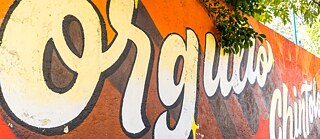Azcapotzalco
"Chintololo Pride" by Alina Kiliwa
Signs and displays are an important part of commercial traditions. Be it on the signs used on vegetable stalls, small corner shops, or the calendars of saints displayed outside bakeries, Mexico has a strong culture of calligraphy and lettering.
For the artist Alina Kiliwa, however, a sign was not big enough to accommodate her ideas. She took to the streets to paint on walls. One of them is to be found in the Azcapotzalco district, where she expresses the attitude to life and emblematic nickname of the local inhabitants. Painted on the wall in yellow and white, on a red and orange background, are the words “Orgullo Chintololo” (Chintololo Pride).
But what does “chintololo” mean? The muralist explains:
“I have always lived in ‘Azcapo’, and the word ‘Chintololo’ refers to the district’s inhabitants. Many of those who live in Azcapotzalco have a penchant for the history and traditions of the original population. That’s why I painted this slogan.”
The name of the local residents comes from the words “Chintli” – meaning rear – and “Tololntic” – meaning round. Indigenous persons can thus be interpreted as having large backsides. However, there is also an interpretation based on the words “Chintun” – meaning small stone – and “T‘otl” – meaning to engrave, which would mean roughly “those who chisel stone”. However, generally the first version is cited, for the local district’s mascot is an ant with a very large rear end.
“I began doing calligraphy at the sociedad de calígrafos, but I always wanted to do murals that would resemble the shop signs found in the streets. I couldn’t find any workshop or place where I could learn this, so I decided to research it myself. While watching signwriters in the streets, I became familiar with techniques and materials, and six years ago began to paint at a number of festivals of urban art.”
Although the lettering technique is in fashion, there are few people who actually use it on the streets: “My first lettering mural, albeit a small one, was on the rooftop of the Mexican Antique Toy Museum (MUJAM) and read: “Never stop playing””. This is a maxim that Alina has always adhered to with her letters.
“I was working in a dangerous area, with glue-sniffers and drunks on every corner who would come closer to look or even to chat. One would always come by, really surprised, and would say ‘ahhh, a few graffiti girls’ and offer us glue or alcohol”, she comments.
“I have always lived in ‘Azcapo’, and the word ‘Chintololo’ refers to the district’s inhabitants. Many of those who live in Azcapotzalco have a penchant for the history and traditions of the original population. That’s why I painted this slogan.”
The name of the local residents comes from the words “Chintli” – meaning rear – and “Tololntic” – meaning round. Indigenous persons can thus be interpreted as having large backsides. However, there is also an interpretation based on the words “Chintun” – meaning small stone – and “T‘otl” – meaning to engrave, which would mean roughly “those who chisel stone”. However, generally the first version is cited, for the local district’s mascot is an ant with a very large rear end.
Über die Künstlerin
Alina explains to us how she made calligraphy part of her art.“I began doing calligraphy at the sociedad de calígrafos, but I always wanted to do murals that would resemble the shop signs found in the streets. I couldn’t find any workshop or place where I could learn this, so I decided to research it myself. While watching signwriters in the streets, I became familiar with techniques and materials, and six years ago began to paint at a number of festivals of urban art.”
Although the lettering technique is in fashion, there are few people who actually use it on the streets: “My first lettering mural, albeit a small one, was on the rooftop of the Mexican Antique Toy Museum (MUJAM) and read: “Never stop playing””. This is a maxim that Alina has always adhered to with her letters.
When painting murals in the street, I always try to leave people with a positive message; the combination of words can convey an infinite number of messages.
Alina Kiliwa
Additional Info
As well as battling with the climate, the facade, and the size of the mural, Alina also faced other challenges when working on her mural:“I was working in a dangerous area, with glue-sniffers and drunks on every corner who would come closer to look or even to chat. One would always come by, really surprised, and would say ‘ahhh, a few graffiti girls’ and offer us glue or alcohol”, she comments.







